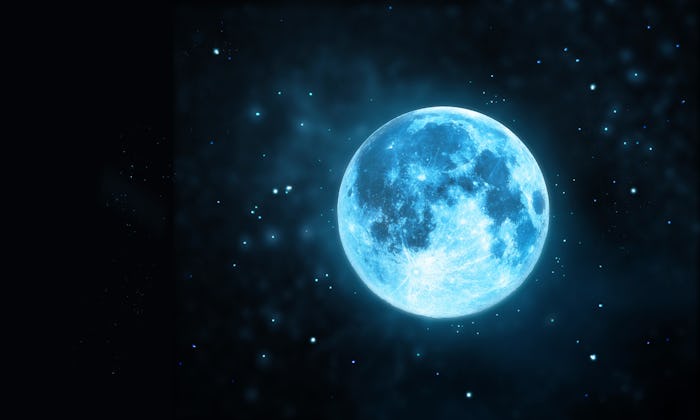Blue moon, supermoon, blood moon, you'd think we'd all be experts on all these lunar events by now. But if you're anything like me, you rarely get the chance to learn a little more in depth information about one before it passes you by. Well, here's your chance to become an expert on the next celestial wonder we'll witness. So what's a blue moon? These seven cool facts will help you get to know the blue moon before it happens on January 31.
Blue moons come with a plethora of cool features, from the fact that their definition was under dispute in the early 1900's to the fact that they aren't even typically blue! We might utter the saying, "once in a blue moon," well, once in a blue moon, but most of us don't know just what a blue moon is or how its name came to be.
There are actually two definitions for a blue moon, according to Space.com. The original was "the third full moon in a four moon season," but in 1946, Sky & Telescope magazine misprinted the meaning of a blue moon as the second full moon to be seen in one month. For whatever reason, this misprint has actually stuck with the majority of the population. Even NASA defined the blue moon as the second full moon of the month, and the one arriving on January 31 is second to the one on January 1.
On top of that, it's also a supermoon (when the moon is closer to the earth in orbit, making it appear bigger and brighter than usual), and a blood moon (it'll pass through the Earth's shadow and look red), explained NASA.
That's just the beginning of the cool facts you should store away before the main event. Here are eight more pieces of info about the blue moon that are really fascinating.
1Blue Moons Are Rarely Blue
Contrary to their name, blue moons rarely look any different in color than a regular full moon. There was a period in the 1800's, however, when blue moons were a regular appearance. In 1883, Indonesian volcano Krakatoa erupted, filling the air with ash that persisted for up to two years and caused the moon to appear blue or green around the world, Science Alert reported. Other volcanos have created the same blue moon phenomenon over the last few centuries, but this all has to do with particles in our atmosphere, not the actual color of the moon itself.
2This Blue Moon Will Probably Be Red
This blue moon on January 31 will likely be red, which is more common for a blue moon. While the ash and dust that is thrown into the atmosphere can sometimes be large enough to obscure light and create a blue colored moon, Space.com explained, while this particular moon is in the earth's shadow, "it'll take on a reddish tint," explained NASA, making it a blood moon.
32018 Will Have Two Blue Moons
The blue moon occurring on January 31 is only the first blue moon of 2018. The second will occur on March 31 this year, as outlined in Earth Sky. This happens once every 19 years, which means perhaps we should change the saying to "once in two blue moons"!
4Blue Moons Are Infrequent
While we often use the colloquialism "once in a blue moon," the phenomenon isn't actually that uncommon. NASA said that blue moons happen once every 2.7 years. The next blue moon after March's will happen in October 2020.
5This Blue Moon Is A Supermoon
Not all blue moons are supermoons, but this one is. A supermoon is a full moon that occurs when the moon is closest to earth, making the moon appear brighter and larger, especially when it is rising in the early evening. Business Insider reported that super moons appear "up to 14% bigger and 30% brighter" than regular full moons.
6It Also Has An Eclipse!
As if a blue-moon-supermoon-blood-moon combo wasn't special enough, the full moon on January 31 also has a total eclipse. The west coast will have the best viewing of the blue moon eclipse, according to Space.com. "Totality will start around 4:51 a.m. PST and last until 6:05 a.m. PST." Other places around the United States might not see the whole eclipse depending on the moon's position in the sky at that point.
7National Parks Are Often Open For Blue Moon Hikes
Check your local national park calendar because many parks hold blue moon hikes. However, if you want to catch the eclipse, you might be on your own since that will likely take place in the early hours of the morning, depending on where you are.
It's really easy to figure out whether and when you can see the super blue moon eclipse, even though it will be different depending on where you are in the world. If you visit Time and Date, the site will let you know if you can see the eclipse based on your location. This special combination only happens once every 250 years, so it's worth getting up at 3 a.m. to have a peek!
Check out Romper's new video series, Romper's Doula Diaries:
Watch full episodes of Romper's Doula Diaries on Facebook Watch.
